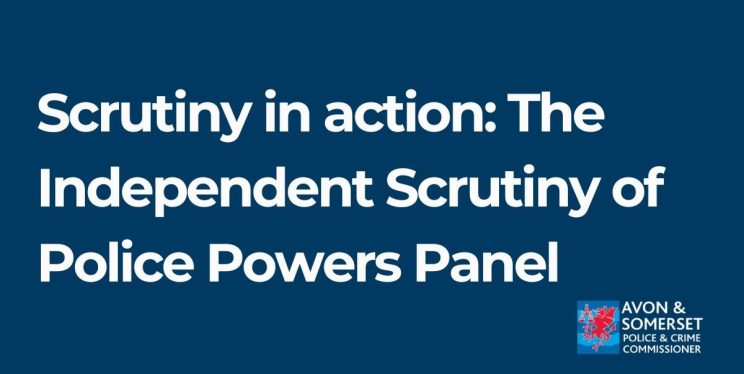Scrutiny in action: The Independent Scrutiny of Police Powers Panel, blog 2

The Independent Scrutiny of Police Powers (ISOPP) comprises volunteers from diverse backgrounds in the local community who play a pivotal role in monitoring the use of force by the police. This is the second of a series of blog posts detailing the panel’s most recent session on 21st March, focusing on the Section 60 Stop and Search powers.
The ISOPP Panel convenes quarterly to scrutinise files and footage related to the police’s exercise of their powers. The meeting is attended by the panel members, representatives from Avon and Somerset Police, and representatives from the Office of the Police and Crime Commissioner. After each meeting, the panel produces a comprehensive report detailing their findings. This report is then submitted to the Police and Crime Commissioner for oversight, as well as to the police for a response.
Section 60
The panel was given an update from Chief Inspector Vicks Hayward-Melen on the recent use of Section 60 in Bristol in response to a number of recent tragic fatal incidents involving knives. Section 60 removes the need for police to have ‘reasonable grounds’ to carry out a stop and search. Section 60 searches cover a specified area, usually a neighbourhood for a defined period of time. This can last initially up to 24 hours but can be extended up to 48 hours. It is regularly reviewed throughout.
Implementation
On 15th February, section 60 was implemented for 24 hours in Bristol city centre, St Pauls, Easton, Temple Meads, and Fishponds. It was extended to cover the following day. This was the first time Avon and Somerset Police have used section 60 in 5 years.
The Chief Inspector explained that Avon and Somerset Police spoke to community leaders ahead of using Section 60, but not as many as they would have liked, and that while of those they spoke to many were against enacting Section 60, the police felt the criteria for implementing it was met.
A video briefing for Section 60 was created and watched by officers on Section 60 Stop and Search best practice and they were informed that the Stop and Searches Body Worn Video (BWV) footage would be reviewed. A number of external videos explaining Section 60 were also released, an example can be seen on the Avon and Somerset Police’s Facebook.
Results
33 searches were completed. No knives were found. It was found that the stop and searches were applied disproportionately to people from black and minoritised backgrounds. Force was used in 9 searches (use of handcuffs) and BWV footage was available for all Stop and Searches. A discussion was had around whether stop and search, including section 60 was a deterrent in stopping people from carrying illegal items including knives.
ISOPP Panel Questions and Feedback on Section 60
ISOPP Panel: “Interested in the view that section 60 had a deterrent effect – did people on the streets know it was in place?”
Chief Inspector: “We briefed out and did media. Neighbourhood colleagues were out. Did put a video for social media.”
ISOPP Panel: “In my community, there was uproar – why did you warn people? They just don’t carry on that day, then they come out the next day. They said ‘They are playing with our lives’. What has been achieved because the knives come back the next day?”
Chief Inspector: “It is mandated in the law, we have to be overt.”
ISOPP Panel: “The mothers, grandmothers want stop and search. But if it’s only black sons getting stopped it’s a problem. The public wants tougher measures but only if they are applied fairly. We need to be intentional, if we see correct policing in the community, you’ll get correct information. If the community sees you are being fair in the application of the law, they’ll talk to you.”
Chief Inspector: “We need to get the balance between information and enforcement. If we talk too much about what we are going to do, it lessens the impact of what we are doing.”
ISOPP Panel: “Nationally 1% of knives are found in section 60 – it’s a blunt tool.”
Chief Inspector: “The context for the section 60 was exceptional circumstances.”
Body Worn Video (BWV) Footage
The panel and representatives from Avon and Somerset Police and the Office of the Police and Crime Commissioner watched selections of dip sampled BWV footage on a large screen. After each video, the panel members asked questions and gave feedback.
The panel are shown the footage of two of the Section 60 Stop and Searches. In one, two black teenagers riding a scooter are stopped. They were handcuffed in front of their bodies.
The panel highlight what goes well: the Stop and Search is calm, clear information is given; the procedures are followed. They question why the teenagers, who were compliant, were handcuffed. This is noted to feedback.
In the second video, two black teenagers are stopped walking in the street in the evening. They are searched, some cannabis is found on one of them. The panel highlights that the manner of the search is good and where the process is followed well. They pick up on one of the teenagers being asked for his name even though he has the right to not give his details as he is not the person with the cannabis. This feedback is noted.
Conclusion
The panel’s findings will be written into a report that will be shared with the police for learning. Some of the feedback will be shared with the officers involved, this can form part of line management discussions and in more serious cases may be used as part of a reflective practice session.
